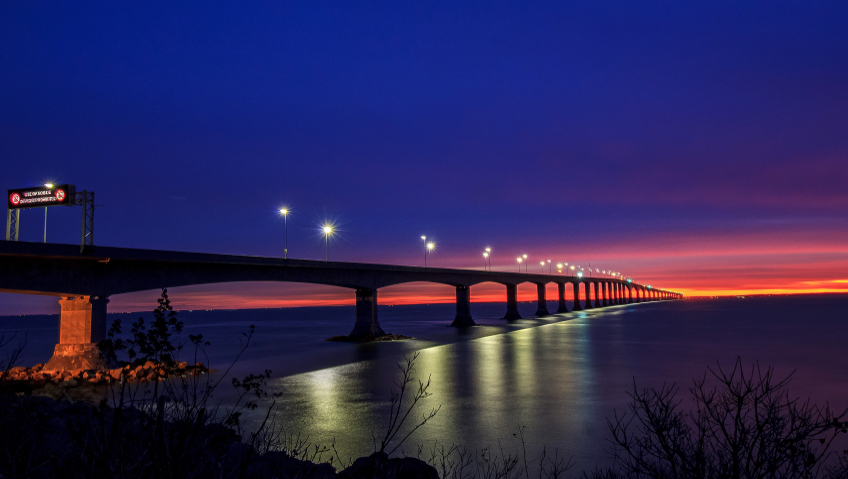The 12.9 km (8.9-mile) Confederation Bridge linking Prince Edward Island to the mainland is a stretch of the Trans-Canada Highway that crosses the Northumberland Strait. But that doesn’t begin to describe a structure which is the longest bridge in the world over ice covered waters.
It’s a true marvel of Canadian ingenuity and engineering and with 4,000 vehicles crossing per day (pre-COVID), it has made a huge economic impact.
The bridge was a long time in the making – 130 years in fact – in final fulfilment of a promise made in 1867 by the newly-formed Dominion of Canada to link Prince Edward Island to the mainland if it joined the Confederation, which it did in 1873.
The promise was initially kept by CN Marine (later Marine Atlantic) which operated a ferry service across the Northumberland Strait, from Borden-Carleton, PEI, to Cape Tormentine, NB, and which for many years transported entire passenger and freight-carrier trains.
Overrun by demand
That solution was far from perfect, however, because it seemed that no matter how many ferries were in operation or how frequently they crossed the strait, they couldn’t keep up with the demands of the tourism or transportation industries, both vital to PEI.
In the years after trains stopped running in PEI, wait times of up to four hours faced commercial transport drivers and young families packed into cars, eager to get to the island’s beaches, or islanders with business on the mainland. And since the ferry service did not operate after midnight, the only way to get off the island in an emergency was by air.
The years of frustration ended on May 31, 1997, with the opening of the appropriately named Confederation Bridge.
The name not only recognizes that long-ago promise to link PEI with the mainland but also acknowledges PEI’s role as “The Cradle of Confederation”. For it was at a meeting held in Charlottetown in 1864, with representatives from New Brunswick, Nova Scotia, and Upper and Lower Canada (Ontario and Quebec), that the idea of forming one nation was born.
Even though it had been obvious for many years that a fixed link, as opposed to a ferry service, was crucial for the island’s economy, there was a surprising amount of opposition in the 1980s when the idea was proposed.
Proponents cited the much-needed economic boost the bridge would provide, but opponents voiced concern around environmental, safety, and financial issues. The debate was settled by a plebiscite in 1988 in which 59.4 percent of islanders voted in favour of the fixed link.
A modern marvel is born
We had the privilege of speaking with Michel Le Chasseur, General Manager of Strait Crossing Bridge Ltd. (SCBL), who arrived on site on October 7, 1993, the day the Government of Canada and Strait Crossing Development Inc. (SCDI) signed the contract to build the bridge, creating a public-private partnership, or P3.
He’s been on the job, ever since, overseeing all aspects of the bridge. “I was only 38 years old when I arrived, and this year I will be 67,” he says.
“It has been an incredible experience and I am extremely lucky to have done this. It’s been my passion. I’ve been supported by a great team, including others who’ve been here since Day One, too. And to me, it’s like winning gold at the Olympics; it’s something I cherish.”
Le Chasseur explains the partnership structure, unique in Canada at that time. It shifts the risk of construction, budgeted in 1993 at $730 million and equal to the subsidy, from the government, and allows SCBL, a wholly-owned subsidiary of SCDI, to recover the delta to the actual cost of $1 billion by collecting tolls which are also used to operate and maintain the bridge for 35 years.
At the end of that time, in 2032, management of the bridge will revert to the Government of Canada, unless it should choose to continue with the present arrangement.
The multi-award-winning 12.9 km bridge, which saw 6,000 employees and sub-contractors cross the gates during the four-year construction period, was designed by a consortium headed by a joint venture of J. Mueller International and Stantec (then SLG Consulting).
It used precast concrete parts, which were fabricated on a 150 acre open yard and assembled on site.
The bridge is composed of a multi-span concrete box girder, with the 11 km long main bridge supported by 44 piers. The 1.3 km New Brunswick approach from Cape Jourimain rests on 14 piers, with 7 piers in the 0.6 km approach from Borden-Carleton, PEI.
“What may be a surprise to people outside the industry, is that the bridge features a hollow core,” Le Chasseur says, “and 12,000 km of cable, which is what really holds it together.” This hollow core allows engineers to carry out regular inspections.
More than just a stroll
Walking the length of the bridge, from PEI to New Brunswick, “is part of our ongoing maintenance program,” says Le Chasseur. “We’re walking and eyeballing, taking pictures and comparing them with the last time we were there. We carry laptop computers, and we can bring up construction drawings to analyze something in particular,” he says.
“Our inspections include going down hollow pier shafts along with diving inspections to see what’s happening at the bottom of the strait. As well, the bridge is equipped with tiltmeters to monitor its movement, and ice flows are also monitored. On top of that, there’s a full annual inspection with independent engineers, and their report goes to the federal government, owner of the bridge, and Strait Crossing,” he explains.
“After 25 years the bridge is in excellent shape and now the thinking is that it will last longer than the 100 years it was designed for. One of the biggest challenges in the construction process was the presence of ice in the strait, but with the warming of the planet, scientists are now predicting there will be no ice in the strait by 2050, which seems to be good news for the longevity of the structure.”
While ironically, the bridge may benefit from global warming and climate change, it has also contributed significantly to the environment by eliminating 44,000 tonnes per year of carbon dioxide and other greenhouse gasses that the ferries produced annually for the past 25 years.
In addition, all the lighting on the bridge has been converted to LEDs that consume 30 percent less energy than the ones used in the initial design.
“We are mindful of whatever we can do in terms of improving the environment. We are talking about micro-solar farms and looking at acquiring electric trucks. They are hard to come by, but we have them on our radar,” says Le Chasseur.
25-year connection
Not only is structural safety paramount, so is vehicle safety. In control rooms at each end of the bridge, traffic is watched 24/7 through 25 cameras posted along the crossing. If a vehicle stops at any point, a patrol vehicle heads out to assess the situation, which could of course be serious or something as trivial as running out of gas.
Ready to respond is a dedicated towing service along with EMS services – fire, police, and ambulance. “We do whatever it takes to keep people safe, including monitoring weather conditions. We’ve been fortunate with very few accidents over the years,” Le Chasseur says.
Things couldn’t have been better for the Confederation Bridge and the tourism and transportation industries until March 2020, when the unexpected occurred: the first of several COVID-19 lockdowns. The bridge remained open, and commercial traffic, deemed an essential service, flowed freely across it, but with restrictions on interprovincial travel, tourism came to a grinding halt.
“What kept us going was commercial traffic, but we had a 40 percent reduction of overall traffic in 2020 and 2021. Because the island doesn’t produce most of what it needs, everything is shipped from the mainland, so it was extremely important for the bridge to remain open when all other travel was strongly discouraged. Commercial traffic became our bread and butter.”
Apart from tourist and commercial traffic, the bridge plays a vital role in helping separated families. “Children go back and forth between parents on weekends, and in the space of a year the cost could be onerous, if you are driving your own vehicle at the 2 axle rate,” Le Chasseur explains.
The solution was to offer a self-serve shuttle for only $4.75 instead of the regular toll of $50.25 (for 2-axled vehicles) in which one parent can drive the children across the bridge to meet with the other parent, as long as the car returns within 40 minutes of departure.
The same program works for other applications such as university students who go back and forth on weekends. “We have 500 such accounts, so that means the system is working.”
Plans to come
Twenty-five years is a milestone anniversary, and Le Chasseur is hoping that he’ll be able to arrange some events of significance, however, COVID-19 and attendant restrictions remain an unpredictable variable.
“COVID has made things difficult, but we think we are moving toward the end of the pandemic and the provincial government is talking about removing restrictions by April 7.”
Still, when we talked in mid-February it was too early to reveal definite plans. “We are looking at different things, but we are not ready to announce.” He hints, however, that it could involve several smaller events spread across the tourist season, starting with the anniversary of the bridge opening on May 31.
“But it will have to be a bit different from our big 20th anniversary celebration which was timed to Canada 150 celebrations.”
Those interested should check social media toward mid-April for announcements.
Meanwhile, the Confederation Bridge remains open, as it has throughout the pandemic, with opportunities for contactless payment through Interact and major credit cards when leaving the island at the toll plaza in Borden-Carleton. Tolls are tax exempt.
Frequent users can utilize the StraitPass transponder system, which is a convenient and secure link to the driver’s credit card. It can also be connected to other toll facilities which accept the MacPass, (for Halifax’s MacDonald and MacKay Bridges and the Stanfield International Airport parking lot) and the E-Pass at the Cobequid Pass, north of Truro on TCH 104.













